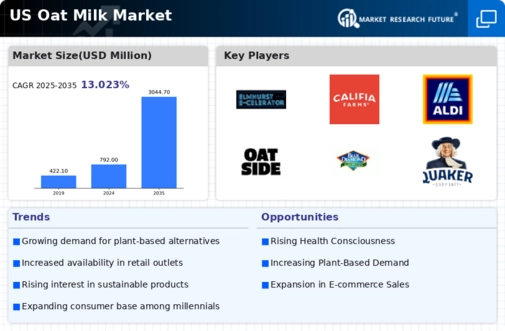Innovations in Product Development
Innovations in product development are significantly influencing the oat milk market. Companies are continuously exploring new formulations and flavors to cater to diverse consumer preferences. For instance, the introduction of fortified oat milk products, enriched with vitamins and minerals, is becoming increasingly common. This trend is supported by data indicating that 30% of consumers are willing to pay a premium for fortified plant-based beverages. The oat milk market is witnessing a surge in creative offerings, including barista blends designed for coffee applications, which enhance frothing capabilities. Such innovations not only attract new customers but also encourage existing consumers to experiment with different products, thereby expanding the overall market.
Rising Veganism and Plant-Based Diets
The increasing adoption of veganism and plant-based diets is a pivotal driver for the oat milk market. As consumers become more health-conscious, they are gravitating towards alternatives that align with their dietary preferences. In the US, the plant-based food market has seen a remarkable growth, with sales reaching approximately $7 billion in 2023. This shift is not merely a trend but appears to be a fundamental change in consumer behavior, as individuals seek to reduce their intake of animal products. The oat milk market benefits from this movement, as oat milk is perceived as a nutritious and environmentally friendly option. Furthermore, the versatility of oat milk in various culinary applications enhances its appeal, potentially leading to increased market penetration and consumer loyalty.
Health Benefits and Nutritional Profile
The health benefits and nutritional profile of oat milk are compelling drivers for the oat milk market. Oat milk is often praised for its high fiber content and low saturated fat levels, making it an attractive option for health-conscious consumers. Research indicates that oat milk can contribute to heart health and may aid in cholesterol management, which resonates with a significant segment of the population. The oat milk market is capitalizing on these health benefits by promoting oat milk as a nutritious alternative to dairy. As consumers increasingly prioritize health in their purchasing decisions, the demand for oat milk is likely to continue its upward trajectory, supported by its favorable nutritional attributes.
Increased Availability in Retail Channels
The increased availability of oat milk in various retail channels is a crucial driver for the oat milk market. Supermarkets, health food stores, and online platforms are expanding their offerings, making oat milk more accessible to consumers. Recent data suggests that oat milk sales in retail outlets have surged by 25% in the past year alone. This growth is indicative of a broader trend where consumers are seeking convenient and readily available plant-based options. The oat milk market is benefiting from this trend, as retailers are recognizing the demand and are more willing to stock a diverse range of oat milk products. Enhanced visibility in stores and online is likely to contribute to sustained growth in consumer adoption.
Consumer Awareness of Environmental Impact
Consumer awareness regarding the environmental impact of food choices is increasingly shaping the oat milk market. As individuals become more informed about the ecological footprint of dairy production, they are more inclined to seek sustainable alternatives. Oat milk is often marketed as a more environmentally friendly option, with studies indicating that its production requires significantly less water and land compared to traditional dairy. This growing consciousness is reflected in the oat milk market, where brands are emphasizing their sustainability credentials. The potential for oat milk to appeal to eco-conscious consumers is substantial, as it aligns with their values and lifestyle choices, thereby driving demand.
























Leave a Comment